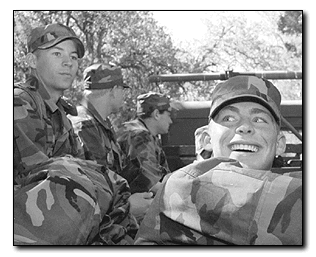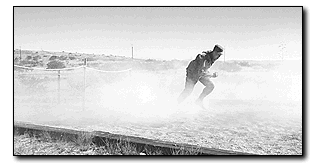![]()
![[ NEWS ]](/images/fall97/newsf97.gif)
![]()
By Bryon Wells
Arizona Daily Wildcat October 31, 1997
Fire in the hole!
![[Picture]](07_1_i.gif)
Dan Hoffman Social and behavioral sciences sophomore Jennifer Fagergren takes the plunge off the 50-foot cliff during Situational Leadership class last weekend. |
The hills of Fort Huachuca were alive with the sights and sounds of battle
Saturday morning.
Smoke grenades filled the air with a green fog cover while enemy fire was simulated by pyrotechnics that mimicked the whistling screech of an incoming artillery barrage, followed by an ear-splitting explosion.
Army boot camp?
Not quite.
The mock war environment was created for the grenade assault course, an exercise during the one-credit Situational Leadership class, a one-weekend field training exercise offered through the UA military science department.
Army ROTC Cadet Capt. Tara Rice said the course is sponsored by the UA Army ROTC, but is open to non-ROTC students on a voluntary basis with no obligation to future military service.
Rice, who will be commissioned a 2nd lieutenant in the U.S. Army in December, said the course is a leadership development course that also instills self-confidence.
"It's a great way to help young people learn about our national defense," she said, "as well as excellent career opportunities."
The grenade assault course was the first event of the weekend.
Forty-two cadets and volunteers low-crawled under barbed wire obstacles and climbed over wooden barricades as they fought their way up the trail, stopping at various stations along the way to throw non-exploding, "dummy" hand grenades at targets to the left and right.
Army Capt. Kirk Armstrong, the UA ROTC enrollment officer, was on the sidelines yelling, "Fire in the hole!" as he ignited the artillery fire simulators.
Most of the students flinched as the simulators exploded, but were still able to land their grenades on or near mark, then move on to the next station as Armstrong shouted words of encouragement.
Having already completed the exercise that morning, Cadet 1st Sgt. Grace Dunfee, a history sophomore, stopped halfway down on the way back to watch some of her comrades charge up the hill.
"I live for this," she said with a grin.

Dan Hoffman Molecular and cellular biology sophomore Cameron Dow (right) laughs at a joke in the back of a five-ton troop transport traveling to the rappelling site in Gardener Canyon. |
The last target was a sandbagged bunker compound at the top of the slightly inclined trail.
As they reached the top, students were instructed to quickly get down on one knee, and were then handed a grenade that contained a small explosive charge, but designed so that fragmentation does not occur.
"Pull the pin and throw," shouted the monitors at the top.
These grenades actually exploded after being tossed into the bunker, but that explosion was completely absorbed by the sandbag structure, recognized only as a deep "thud."
Architecture senior David Molinar said he just took the course for fun, and to take a break from his studies.
After finishing the exercise, Molinar stopped to catch his breath.
"It's a workout," he said between quick gulps of air.
"Dirt."
"Dust."
"Smoke."
"I love it!"
After the last person completed the grenade assault course, students gathered into teams, or squads, to cleanup the debris left on the sand and rock trail.
The squads then filed onto chartered buses for a short drive to waiting five-ton military transport vehicles.
The six-wheeled vehicles then gave them a bumpy ride up a mountain road to the site of the next event ... rappelling in Gardener Canyon, also on the Fort Huachuca Military Reservation, in Sierra Vista.
Rappelling is a rock climbing method that utilizes the shortest and fastest way to descend a cliff or rock face: jumping off, straight down.
Actually, it is quite safe when you're fastened to a rope.
Armstrong said he personally has sent thousands of cadets safely down cliffs such as this.
When the uncovered five-ton trucks reached the top, the vehicles jerked to a stop with an audible whine from their air brakes.
The students gladly jumped out of the vehicles only to assemble before Army Sgt. Lee Thayer.
Thayer gave the cadets and volunteers quick instructions on how to wrap the rope harness around themselves.
First around the waist, then down under the groin, and around the waist again, then tied-off for a tight fit.
The harness holds a D-ring, a clip that is then latched on to the rappel line.
Armstrong said the type of rope used can hold 3,000 pounds, and the D-ring can withstand 12,000 pounds of pressure.
After donning a helmet and leather gloves, the students-turned-mountaineers climbed a trail to the top of the cliff. Most were excited, though some a little apprehensive.
"I'm afraid of heights," one of the student rappellers joked as the group lined up atop the cliff.
The highest point was about 50 feet, Thayer said.
Armstrong was one of three "rappel masters" at the top who would check the fit of their harnesses before letting them down.
The maneuver was first demonstrated by Cadet Maj. Nathan Betts, a geological engineering senior.
Armstrong explained the process to the eagerly waiting faces, as Betts stepped up to the cliff with his back to the edge.
"Your brake hand is the one at your back. To descend, extend your brake hand not straight out, but at a 45 degree angle," Armstrong said.

Dan Hoffman Free of the first barbed wire obstacle, ROTC cadet and history sophomore Thomas Pike runs through thick smoke to the next station on the grenade assault course. |
Betts walked backward down the cliff three steps until he stopped in an "L" shaped position with his feet extended and knees locked.
"Keep your knees locked," Armstrong said, "otherwise you'll slide into the rock with your teeth."
Then he turned to Betts and said, "OK, you're on your own."
At that, Betts extended his brake arm and leaped downward.
The zipping sound of the rope sliding through the D-ring and Betts' gloves filled the air until he brought his brake hand to his back, coming to an abrupt stop at the bottom of the hill.
The cliff face was a swarm of activity from about 1 to 4 p.m. as the students went up and down the three different rappel points, each varying in distance.
Many joked around at the top while they waited for their turn.
One of the volunteers, Robyn Amster, a political science senior, was fine until she reached the edge.
Armstrong hooked her up to the rope and she changed her mind about what she was about to do.
"No," she said with a pleading look on her face, "I can't do this."
Armstrong's voice turned from authoritative to reassuring as he convinced her that she was perfectly safe.
With his constant assurance, Amster overcame her fear and did what she thought she could not do, she reached the bottom in one piece.
Aside from minor bumps and bruises sustained by some of the students, there were no injuries.
And many of them managed to leave their fears behind - at the top of the canyon.
With the day's challenge of cliffs and explosions out of the way, the exhausted students looked forward to "chow" and rest before the following and final day's land navigation exercise, a challenge of wits.



